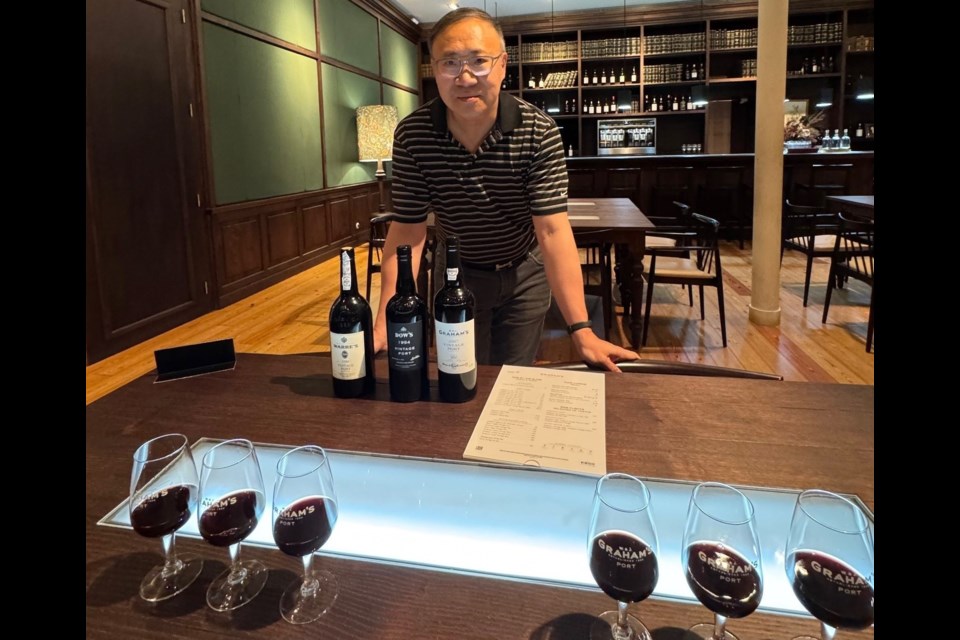Port is one of the most underappreciated wines in the world.
Because port is sweet, it is quite easily accepted by novice drinkers and wine lovers alike.
There is such a variety of different types of ports, and there is also a very wide range of prices, which makes ports very accessible to all consumers.
Even very old ports are relatively inexpensive compared to top-shelf still wines.
I was recently in Portugal and had an opportunity to take a cellar and port tasting tour at Graham’s Port House.
This port house was established in 1820 by William and John Graham, and the lodge where the cellars are situated and the tasting occurs was built in 1890.
Although most people associate port with the city of Porto, the cellars of the port houses are all located in Vila Nova de Gaia, which is a separate city that is connected to Porto by many bridges.
I walked across one of these bridges and experienced the magnificence of seeing these two cities divided by the Duoro River!
Port is a fortified wine that is created when the fermentation of the sugar in grapes that is converted to alcohol is stopped.
Port houses do this by adding a neutral grape spirit (normally aguardente or brandy) to raise the alcohol level of a port to around 20 per cent.
At that point, yeast, which is added to assist the fermentation process, can no longer survive, leaving residual sugar from the grapes in the wine.
So what is produced as a sweet, high alcohol content port, which has the characteristics of many fine wines?
The best grapes for producing port wines are located in Portugal.
Some of the most popular types are Touriga Francesa, Touriga Nacional, Tinta Roriz and Tinto Cão.
The grape varietals are rarely used outside of Portugal, although some port houses may produce still wines using these grape varietals.
On our tour, we learned there are two basic types of port: ruby and tawny ports.
Generally, ruby ports are not aged in wood for a long period of time and maintain their ruby colour and fruit flavours.
Some ruby ports can improve with age in the bottle. In contrast, tawny ports are aged in wood barrels for an extended period of time, changing the colour of the port to a tawny or brownish colour.
They will have more dried fruit, nut and caramel notes.
At Graham’s, I only tasted vintage ports, which are a special type of ruby port that is only produced in the best years.
In these years, grapes from one vintage are aged for two to three years in oak barrels and then bottled.
Like fine wines, vintage ports continue to develop complexity and flavours after they are bottled.
Typically, it will take a vintage port 15 to 20 years to get to its optimum drinking window, and many vintage ports can be enjoyed 50 or more years after the vintage.
Graham’s is now owned by the Symington family, who also own other port houses.
As one of the largest port houses, I was able to taste ports from different port houses in one location!
Like champagne houses, each port house has its own distinct style. I was served the 1980 Warre’s Vintage Port, the 1994 Dow’s Vintage Port and the Graham’s 2007 Vintage Port.
I loved all of them in different ways, but my personal favourite was the 1980s Warre’s, which is fully mature and has a great concentration of dark fruits, figs, cinnamon, cardamom and plums with a tobacco and cedar aftertaste.
It is so smooth and easy to drink that you forget the alcohol content is 20 per cent!
I splurged and had a glass of Graham’s 50 Year Old Tawny Port. It has an orange brown, cognac-like colour with orange blossoms, quince, toffee and caramel notes.
Our tour guide showed me a small bottle of their Ne Oublie, which is a single year tawny port made from 1882 grapes that have been aged in wood for 130 years before bottling.
You can actually try this wine at Graham’s for 800 Euros a glass!
I had a tremendous time learning and tasting port at Graham’s 1890 Port Lodge. If you want one comprehensive tour in Porto/Vila Nova de Gaia, I would recommend visiting Graham’s. For more information about my tour and my full tasting notes of the ports I tried, see here.
For more information on Graham’s Port Lodge Tours, please see their website by clicking here.
They offer a wide price range of tours and tastings. The difference in price reflects whether you are taking a group or private tour and the quality of ports you would like to taste.
Until next time, happy drinking!
Tony Kwan is a Richmond News columnist. Lawyer by day, and a food and wine lover by night. Kwan is an epicurean who writes about wine, food and enjoying all that life has to offer.
📣 Got an opinion on this story or any others in Richmond? Send us a letter or email your thoughts or story tips to [email protected].
📲 To stay updated on Richmond news, sign up for our daily headline newsletter.
💬 Words missing in article? Your adblocker might be preventing hyperlinked text from appearing.



